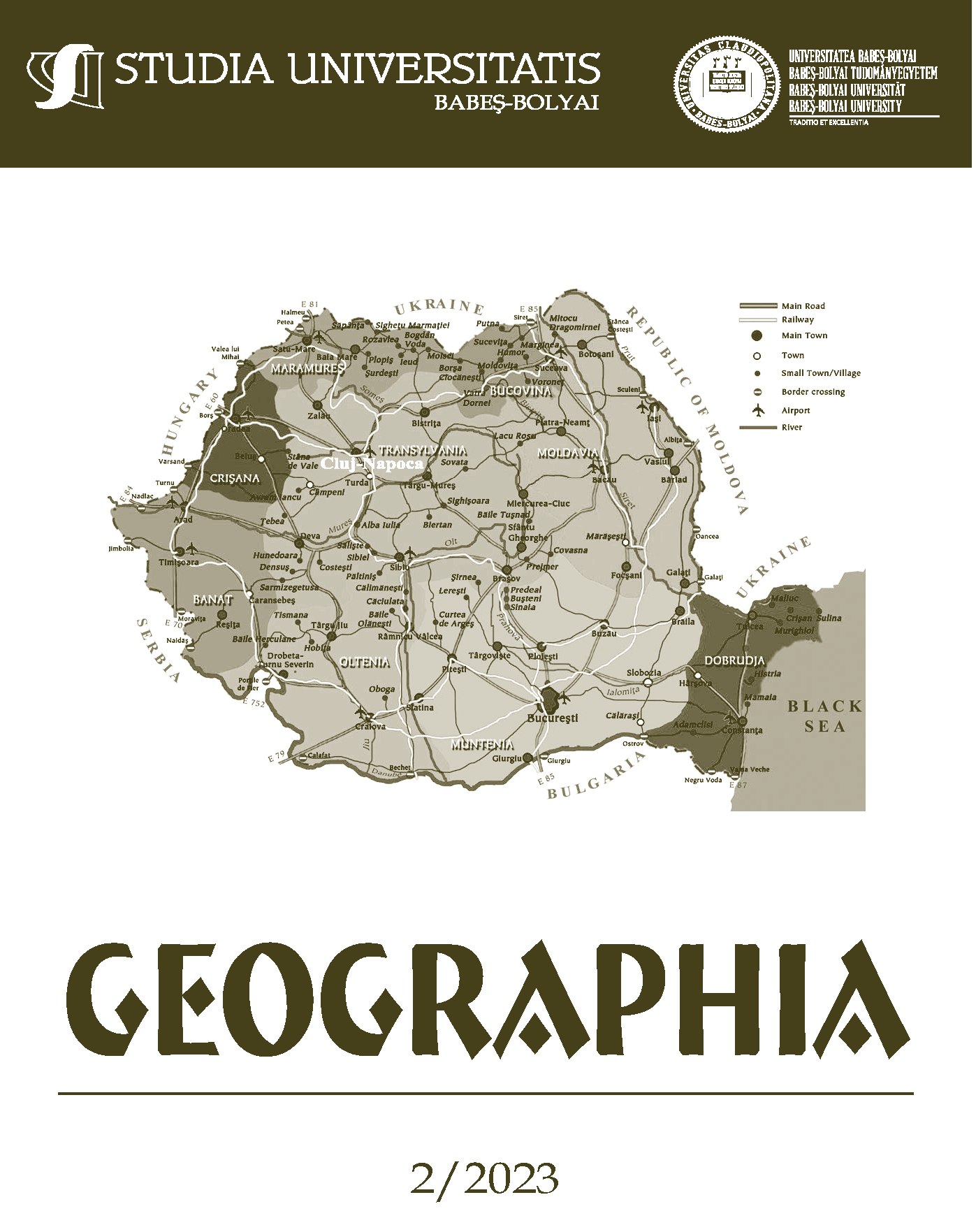Analysing the Capacity of the Urban Road Transport Network Using a Dynamic Assignment Model in The Bistrița - Târgu Mureș Geographical Axis
DOI:
https://doi.org/10.24193/subbgeogr.2023.2.05Keywords:
Traffic-flow relation, Intelligent Transport System, Dynamic assignment model, Road urban transport network, road network capacity, Geographic Axis Bistrița - Tg. MuresAbstract
Network capacity in a transportation system becomes an important measurement for transport planning and management because it addresses its capability to satisfy an efficient network traffic flow reducing the inefficiency of congestion phenomena. This work provides a discussion of road urban transport network capacity including existing definitions in literature and the validation of new measurement methods. The study explores some of the properties of network-wide traffic flow relationships in a large-scale complex urban street network using real-time simulated results obtained from a dynamic traffic assignment model, periodically updated by data from radar sensors through rolling horizon technics. The basic variables used in the methodology, such as network flows and speeds, are characterized using a network model calibrated in the urban area of the geographical axis Bistrița-Târgu Mureș. For a comprehensive yet simple analysis, equations, and graphs are utilized to resume the obtained results related to different days and several time intervals of the day. The focus of sustainable urban transportation development lies in realizing the untapped capacity potential of the existing road network and enhancing its operational efficiency without expanding its physical footprint. To quantify the supply capacity of road networks in mountainous cities, this paper converts the problem of solving the capacity of road networks into the problem of solving the minimum cut set in road networks from the perspective of road network capacity, using the idea of the auxiliary diagram method in graph theory. This procedure proved to be suitable for investigating the properties of network-level traffic flow relationships and concluding remarks include suggestions for further research in this highly promising area.References
Akamastu, T., Miyawaki, O., (1995), Maximum network capacity problem under the transportation equilibrium assignment, Infrastr Plann Rev, 12, p. 719–729.
Asakura, Y., Kashiwadani, M., (1993), Estimation model of maximum road network capacity with parking constraints and its application, Infrastr Plann Rev, 11, p. 129–136.
Beckmann, M., McGuire, C.B., Winsten, C.B. (1956), Studies in the Economics of Transportation, Yale University Press, Yale, CT, USA, 266 p.
Bauer, D., Richter, G., Asamer, J., Heilmann, B., Lenz, G., Kölbl, R. (2018), Quasi-Dynamic Estimation of OD Flows from Traffic Counts Without Prior OD Matrix, IEEE Trans. Intell. Transp. Syst., 19, p. 2025–2034.
Ben-Akiva, M., Bierlaire, M., Koutsopoulos, H., Mishalani, R. (1998), DynaMIT: A simulation-based system for traffic prediction, Proceedings of the DACCORD Short Term Forecasting Workshop, Delft, The Netherlands, February, pp. 1–12. Available online: http://www.es.lancs.ac.uk/cres/daccord/workshop.html, last accessed on 24 September 2023.
Benenson, I., Martens, K., Rofé, Y., Kwartler, A. (2011), Public transport versus private car GIS-based estimation of accessibility applied to the Tel Aviv metropolitan area, Ann. Reg. Sci., 47, p. 499–515.
Daganzo, C.F., Geroliminis, N. (2008), Existence of urban-scale macroscopic fundamental diagrams: some experimental findings, Transp Res BMeth, 9, p. 759–770.
Ford, L.R., Fulkerson, D.R., (1956), Maximum flow through a network, Can J Math, 8, p. 399–404.
Godfrey, J.W., (1969), The mechanism of a road network, Traffic Engineering and Control, 11 (7), p. 323-327.
Horni, A., Nagel, K., Axhausen, K.W. (2016), The Multi-Agent Transport Simulation MATSim, Ubiquity Press, London, UK.
Knoop, V., Hoogendoorn, S., van Lint, J.W.C. (2013), Impact of traffic dynamics on macroscopic fundamental diagram, Transportation Research Board, 92nd Annual Meeting, Washington DC, No. 13-0595.
Iida, Y., (1972), Methodology for maximum capacity of road network, Trans Jpn Soc Civ Eng, 205, p. 147–150.
Mahmassani, H.S., Williams, J.C., Herman, R. (1984), Investigation of network-level traffic flow relationships: some simulation results, Transportation Research Record: Journal of the Transportation Research Board, No. 971, p. 121-130.
Mahmassani, H.S., Williams, J.C., Herman, R. (1987), Performance of urban traffic networks, Proceedings of the 10th International Symposium on Transportation and Traffic Theory, Elsevier Science Publishing, p. 1-20.
Rodrigue, J.-P. (2020), The Geography of Transport Systems, Routledge, New York, 456 p.
Smeed, R.J. (1966), Road capacity of city centres, Traffic Engineering and Control, 8 (7), p. 455-458.
Thomson, J.M. (1967), Speeds and flows of traffic in central London: 2. Speed-flow relations, Traffic Engineering and Control, 8 (12), p. 721-725.
Wardrop, J.G. (1968), Journey speed and flow in central urban areas, Traffic Engineering and Control, 9 (11), p. 528-532.
Yang, H., Bell, M.G.H., Meng, Q. (2000), Modelling the capacity and level of service of urban transportation networks, Transp Res Part B-Meth, 34(4), p. 255–275.
Zahavi, Y. (1972), Traffic performance evaluation of road networks by the α-relationship, Parts I and II, Traffic Engineering and Control, 14 (5, 6), p. 228-231, 292-293.
Downloads
Published
How to Cite
Issue
Section
License
Copyright (c) 2023 Studia Universitatis Babeș-Bolyai Geographia

This work is licensed under a Creative Commons Attribution-NonCommercial-NoDerivatives 4.0 International License.





 ©Studia Universitatis Babeş-Bolyai Geographia. Published by Babeș-Bolyai University.
©Studia Universitatis Babeş-Bolyai Geographia. Published by Babeș-Bolyai University.